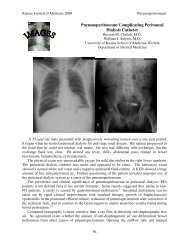A Chronic Care Model Program Incorporating Group Office Visits for ...
A Chronic Care Model Program Incorporating Group Office Visits for ...
A Chronic Care Model Program Incorporating Group Office Visits for ...
You also want an ePaper? Increase the reach of your titles
YUMPU automatically turns print PDFs into web optimized ePapers that Google loves.
Kansas Journal of Medicine 2011 <strong>Chronic</strong> <strong>Care</strong> <strong>Model</strong> <strong>Program</strong><br />
and 10 to the control arm and had baseline<br />
measurements. At week 16, eight<br />
participants in the control arm and 16<br />
participants in the active arm returned <strong>for</strong><br />
assessment. Six participants in the control<br />
arm and 17 participants returned <strong>for</strong> the<br />
assessment at week 24. Among the<br />
participants of the active arm, 14<br />
participants returned <strong>for</strong> the assessment at<br />
week 16 and attended more than 50% of the<br />
16 weekly sessions. These subjects were<br />
program “completers”. Figure 1 describes<br />
participant enrollment and retention in<br />
greater detail.<br />
For the intervention arm, each<br />
individualized assessments session prior to<br />
group meetings was provided by a primary<br />
care physician (author ACE), a clinic RN, or<br />
a psychologist (authors CAB or ABD).<br />
During the course of the 16-week<br />
intervention, four individualized assessments<br />
were provided by the physician, four<br />
by the nurse, and eight by one of the<br />
psychologists. For each session, all participants<br />
were assessed by the same provider.<br />
Participants were advised to set realistic,<br />
guideline-based goals <strong>for</strong> weight control<br />
including 1-2 pound weight loss per week,<br />
150 minutes of moderate/vigorous physical<br />
activity per week, less than 25% daily<br />
calories from fat, five servings or more of<br />
fruits and vegetables per day, and an overall<br />
goal of 10% body weight loss and weight<br />
loss maintenance. At each meeting,<br />
participants reviewed goals and problemsolved<br />
to reduce barriers of weight control<br />
adherence.<br />
Statistical analysis. Univariate analysis<br />
compared patient characteristics at baseline<br />
between the two arms. For continuous<br />
variables, such as weight, the two sample ttest<br />
was used <strong>for</strong> comparison if the<br />
normality assumptions were satisfied;<br />
otherwise, the Wilcoxon rank sum test was<br />
used. The Chi-square test was used <strong>for</strong><br />
categorical variables such as gender and<br />
90<br />
race. For the changes of outcome variables<br />
from baseline to 16 and 24 weeks, twosided,<br />
a two-sample t-test or Wilcoxon rank<br />
sum test was used.<br />
Three different sets of analysis were<br />
used on the changes of outcome measures.<br />
First, an analysis based on observed data<br />
only. All individuals with missing<br />
in<strong>for</strong>mation were excluded <strong>for</strong> the<br />
corresponding analysis. Second, an intentto-treat<br />
analysis included all individuals<br />
randomized, <strong>for</strong> which the simple lastobservation-carried-<strong>for</strong>ward<br />
(LOCF) strategy<br />
was used to replace missing values. The<br />
LOCF strategy is equivalent to assuming no<br />
changes since last time of measurement.<br />
Finally, given the well-known problem of<br />
recidivism in weight control studies, an<br />
analysis of “completers” included<br />
individuals in the control arm who had no<br />
missing observations and those in the active<br />
arm who had no missing measures and<br />
completed at least 50% of group office<br />
visits. As an exploratory pilot study, no<br />
control <strong>for</strong> multiple tests was considered.<br />
All analyses were conducted using STATA<br />
10 (STATACorp LP, College Station, TX).<br />
Analysis of the interviews was thematic<br />
in approach. 29 The participants’ responses<br />
were reviewed and reduced to key themes.<br />
Discussion of the themes and topics were<br />
held between the first author (EAC) and the<br />
interviewer (CG).<br />
Results<br />
The 29 participants were 49.8 ± 11.5<br />
years old (mean ± SD), 97% female, 55%<br />
white, and 41% black. Baseline body mass<br />
index (BMI) was 37.5 ± 5.4 (mean ± SD),<br />
baseline body fat percentage was 48.7% ±<br />
4.9%, and baseline total daily energy intake<br />
as measured by one baseline 24-hour diet<br />
recall was 1738.1 ± 821.9. Additional<br />
baseline descriptions are in Table 1. Except<br />
<strong>for</strong> body fat, variables were not significantly<br />
different between the two arms.











